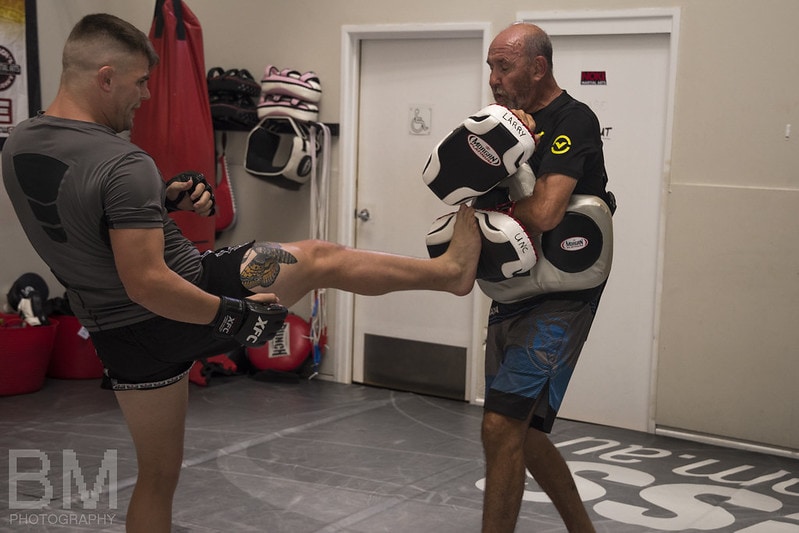How to Throw a Teep,Front Kick or Push Kick
The teep or the push kick is a staple in the Art of the eight limbs. It is used as a sort of a jab to measure the distance between you and your opponent and to also keep your opponent as far away as you want. It can also help you set up a combination and to keep your opponent guessing at all times. There is no good Muay Thai training session with at least some kind of teep combination being practiced.
The Teep Is Not The Same As The Front Snap Kick
The Front Snap Kick, which is Anderson Silvas’s signature move, is often confused with the Muay Thai teep. But there are some stark differences between these two kicks. The teep is meant to produce the force of your kick in a horizontal direction (into your opponent’s torso), while the front snap kick is supposed to produce the force vertically into your opponent’s face. There is also a difference in the source of power between these two kicks. The power for the teep comes from the back leg and the hips, while the power for the front snap kick comes from the quadriceps and the knee extending.

Where Does The Power Come From?
The power in the teep kick comes primarily from the hips. This is why flexibility and a full range of motion in the hips are necessary. A fuller range of motion will help the fighter produce more power into his kicks and punches. To generate more power, fighters will push off their back leg from the ground just before impact. This gives them a better base to push off of and helps transfer more energy into the kick. Additionally, the back leg provides a sort of counterbalance that helps keep the fighter stable as they deliver the blow. Another important thing that helps the fighter generate power during the teep is swinging down with the same sidearm. This gives you the full potential of the force you are able to release, making your teep even more powerful.
How To Throw The Teep?
There are many different ways to throw a front kick/teep, but the most important thing is to make sure that you extend your leg fully and snap your hip into the kick. Here’s how to do it:
1. Start in a stance with your feet shoulder-width apart and your hands up in front of you, ready to defend.
2. Shift your weight onto your left foot and raise your right leg up to parallel your thigh to the ground.
3. As you bring your right leg forward, snap your hip forward and extend your leg while simultaneously pushing off from your back leg, striking with the ball of your foot or with the top of your foot if you are just trying to keep the opponent at bay. At the same time, your right arm should swing down to help you bring as much force out of the kick as you can.
4. Keep the opposite arm up to protect yourself from the opponent’s incoming punches.
5. Be mindful of getting back into position as quickly as possible after throwing the kick since you do not want your opponent to find an opening in your defense. You can do that by first pulling your hips back and putting your right foot back into its position. Do not just let your right foot fall to the ground after making contact with the opponent.
You can throw the teep with your left and your right leg; the principle stays the same but keep in mind that throwing the teep with your back leg will produce more force and throw your opponent further away. The teep with the front foot is just there to be used as a distance measurer. Just like with your jabs and your crosses, the same principle applies.
Where To Aim?
Your primary aim with the teep should be to keep your opponent at bay, measure the distance between the two of you, and set up a combination. You should mainly aim for your opponent’s stomach or chest, where his center of gravity is. By hitting your opponent’s center of gravity, you are forcing the opponent backward. You can also throw a teep to the face, but keep in mind that is seen as an act of disrespect since the foot in Thai culture is seen as the lowliest part of the body while the head is seen as the most highly. By hitting your opponent, especially a Thai opponent, you just might make them angry.
Other Uses For The Teep
Some other uses for the teep are throwing feints to keep your opponent always guessing or my personal favorite to throw faints into combinations. For example, you can throw a fake teep into a flying knee or a faint teep into and 12 to 6 elbow onto your opponent. One of the most popular uses of the teep faint is to throw a question mark kick just after it.
The teep also helps your training partner to work on the abdominal muscles since they have to squeeze them every time they take the hit into the abs. This will prepare your training partner for teeps during a fight or a sparring session and will also help them strengthen their abdominal muscles.
Conclusion
You can use a teep to keep your opponent at a distance, to create space so that you can land other strikes, or to set up for a takedown. Teeps can be used in both offensive and defensive situations and are a versatile tool that every Muay Thai fighter should master. You can throw the teep with your back and your front leg. And remember, most of your power when throwing a teep comes from your hips and your back leg.







